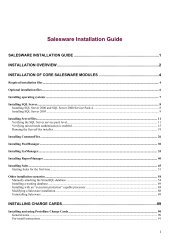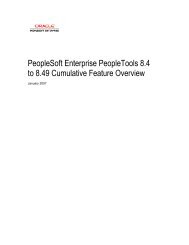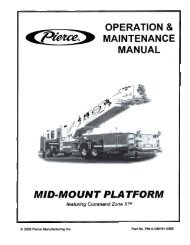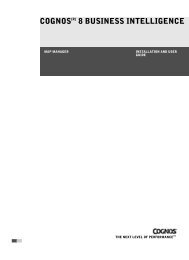COGNOS Business Intelligence Series 7
pes.pdf
pes.pdf
You also want an ePaper? Increase the reach of your titles
YUMPU automatically turns print PDFs into web optimized ePapers that Google loves.
Appendix C: Managing Temporary Files<br />
Configuring Mirrored Servers and Cubes<br />
In a default installation of PowerPlay Enterprise Server, when a gateway and dispatcher are<br />
installed on the same machine, the Temporary File Access property is set to Shared Temp by<br />
default. This means that the gateway and the dispatcher share the same PPWB_DIR directory.<br />
Any mirrored server or cube in this configuration must also share the same PPWB_DIR directory.<br />
PPWB_DIR for both servers should point to the same disk location. The Web server must have<br />
read/write access to the Temp directory. In certain Web-based deployments, however, your Web<br />
server may not be able to access a shared drive directly. In this situation, you should set the<br />
Temporary File Access property to CGI or Dispatcher, depending on where the Temp directory is<br />
located, instead of the default Shared.<br />
The following table shows the permissions that the Web server and the dispatcher have to the<br />
Temp directory, depending on the setting you choose for the PPWB_TEMP_ACCESS property in<br />
Configuration Manager.<br />
CGI Shared Dispatcher<br />
Dispatcher n/a read/write read/write<br />
Web server read/write read n/a<br />
Fetch Temporary Files<br />
The fetch temporary files option can be used as an alternative to the sticky bit setting on your<br />
router. If you use the sticky bit setting, all communications related to a particular request are<br />
always passed to the same Web server. You can maintain better response times and a balanced<br />
load by using this option.<br />
Use the fetch temporary files option to specify which temporary file location PowerPlay Web<br />
Explorer uses when building a report. When a user requests data, PowerPlay creates a Web page<br />
for the data and a customized toolbar. The Web page is stored in the temporary file location until<br />
requested by the user’s Web browser. The temporary location is the ppwb\temp directory which is<br />
normally on your Web server. When you enable this option, PowerPlay uses the ppwb\temp<br />
directory on the PowerPlay dispatcher to store its temporary files.<br />
You can also use the fetch temporary files option if you have several Web servers, where requests<br />
are handled through a router. Because the data for a PowerPlay Web Explorer report is passed to<br />
the Web browser in two parts, you must enable fetch temporary files so that the temporary data is<br />
stored at the shared level of the PowerPlay server. When PowerPlay processes requests for multiple<br />
Web servers, this option ensures that the URLs for the data and customized toolbar can always be<br />
resolved, regardless of which Web browser requested the report.<br />
Steps<br />
1. In PowerPlay Enterprise - Server Administration, click a server.<br />
2. From the Edit menu, click Properties, and then click the Settings tab.<br />
3. In the Fetch Files box (Options), type 1.<br />
4. Click Apply.<br />
5. Click OK.<br />
Fetch Files is now enabled.<br />
Setting the Base HREF<br />
The Web page sent to a user by PowerPlay Web Explorer consists of frames that contain URLs<br />
that are relative to the URL of the Web page. If your server configuration includes a router, these<br />
URLs may be incorrect, and the Base HREF value must be set to the name of the external server.<br />
Steps<br />
1. Start the Configuration Manager<br />
110 Cognos PowerPlay (R)
















